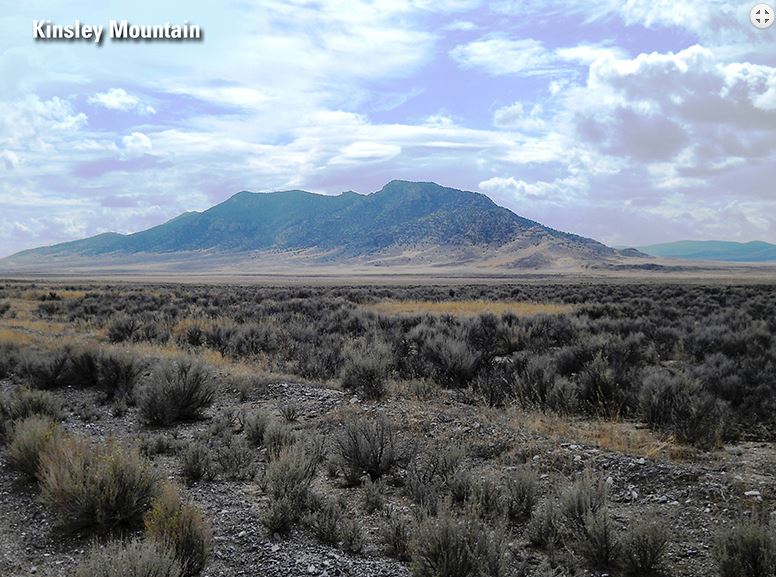Pilot Gold reports high-grade gold resource for Kinsley Project

The Kinsley Mountain property of Pilot Gold and Nevada Sunrise Gold, Elko County, Nevada. Source: Nevada Sunrise Gold Corp.
Pilot Gold Inc. [PLG-TSX] reported the first independent resource estimate for its Kinsley property in Elko County, Nevada. The resource estimate defines a significant high-grade zone at the Western Flank along with near-surface oxide ounces. Gold mineralization at Kinsley is sedimentary rock-hosted, similar to that mined in Nevada’s prolific Carlin and Cortez trends. The potential for resource expansion is excellent due to widespread alteration, prospective geology and gold at surface and over 80% of the property is untested by drilling.
The resource estimate for all mineralization types, using multiple cut-offs, is:
Matt Lennox-King, President and CEO stated, “With a large number of untested targets with attributes similar to the Western Flank Zone, we believe that this resource represents a stepping stone along the way to defining a much larger gold endowment at Kinsley. From north to south, we have over 12 km of prospective geology, alteration and geochemical targets to explore. We are confident that the Western Flank is one of many high-grade zones of its type at Kinsley and we are aggressively pursuing the next one.”
Mineralization hosted in the Secret Canyon Shale in the Western Flank Zone includes 284,000 Indicated ounces at an average grade of 6.04 g/t gold. At a 3 g/t cut-off grade, most of the resource remains, delineating 248,000 Indicated ounces averaging 9.15 g/t gold. The grade improves 51%, while the gold content is only reduced by 13%. Metallurgical testing of mineralized material from this zone suggests that it is amenable to production of a flotation concentrate with grades up to 312 g/t gold and recovery of up to 95% (see press releases, July 13, 2015 and January 19, 2015). The outstanding metallurgical response indicated by testing to date allows for consideration of a potentially low cost development scenario that may minimize financial and permitting challenges of typical refractory ore bodies in Nevada. This in turn allows for lower cut-off grades than might ordinarily be used in modeling Carlin-type sulphide material.
           To view the resource block model, go to: http://pilotgold.com/sites/default/files/KinsleyResource2015.pdf
The resource estimate, effective October 15, 2015, includes three separate cut-off grades, reflecting depth from surface, oxidation, and metallurgical considerations. These include shallow oxidized rock (0.2 g/t Au cut-off); shallow transitional and sulphide mineralization, primarily hosted in the Dunderberg Shale (1.3 g/t Au cut-off), and Secret Canyon Shale-hosted sulphide and transitional mineralization (1.0 g/t Au cut-off). Cut-off grades assume an open-pit mining scenario, using a pit floor elevation generated using Whittle software, reasonable assumptions for mining and milling costs, and a US$1,300/oz gold price.
The resource estimate is based on results from 77,097 metres of historical drilling in 1,158 drill holes (9 core and 1,149 reverse circulation or rotary), as well as 59,852 metres in 222 holes, including 74 core holes and 148 reverse circulation holes drilled by Pilot Gold.
To ensure reasonable prospects of economic extraction, the project resources were limited to elevation levels as defined by Whittle pit shells. A pit optimization was run using a US $1,300/oz gold price and parameters applicable to: (i) oxidized, potentially heap-leachable mineralization – $2.50/t processing cost, $1.41/t General and Administrative (G&A) cost, and a gold recovery of 75%; (ii) mixed and unoxidized mineralization that could potentially be processed by flotation, leaching of the flotation tails, and custom oxidation by roaster or autoclave – $32.00/t processing cost, $7.04/t G&A cost, and 85% recovery; and (iii) mineralization hosted within the Secret Canyon Shale, which potentially could also be processed by flotation, leaching of the flotation tails, and custom oxidation by roaster or autoclave - $28.30 processing cost, $7.04/t G&A cost, and 95% recovery.
The pits were used to define the following maximum depths below the topographic surface for the potentially open-pit resources at Kinsley: 125 metres below the topographic surface on the east side of the Kinsley Mountains and 350 metres below the surface on the western side.
Tonnage estimates are based on 129 bulk specific gravity determinations completed by ALS Laboratories for Pilot Gold, as well as historical data, which were used to assign average values to oxidation domains of the block model.
Kinsley Mountain hosts near-surface mineralization similar to other Carlin-style, sediment-hosted gold systems. The property consists of 513 unpatented lode claims on U.S. Bureau of Land Management land plus 6 leased patents totaling  4213 hectares, and hosts a past-producing mine with an extensive exploration database and numerous, untested gold targets.
Pilot Gold holds approximately 79.1% of Kinsley. Intor Resources Corp., a subsidiary of Nevada Sunrise Gold Corp. [NEV-TSXV], is the company’s joint venture partner at Kinsley.

